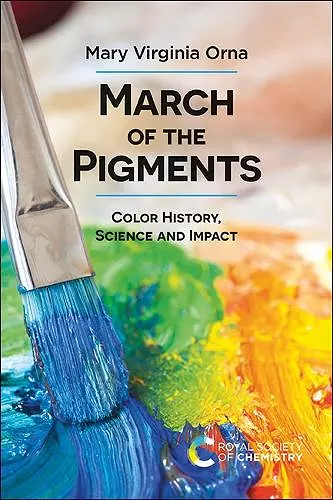March of the Pigments
Color History, Science and Impact
Format:Hardback
Publisher:Royal Society of Chemistry
Published:23rd May '22
Currently unavailable, and unfortunately no date known when it will be back

Take a colorful walk through human ingenuity.
Humans have been unpacking the earth to use pigments since cavemen times. Starting out from surface pigments for cave paintings, we’ve dug deep for minerals, mined oceans for colors and exploited the world of plants and animals. Our accidental fumbles have given birth to a whole family of brilliant blues that grace our museums, mansions and motorcars. We’ve turned waste materials into a whole rainbow of tints and hues to color our clothes, our food and ourselves. With the snip of a genetic scissor, we’ve harnessed bacteria to gift us with “greener” blue jeans and dazzling dashikis. As the pigments march on into the future, who knows what new and exciting inventions will emerge?
Mary Virginia Orna, a world-recognized expert on color, will lead you through an illuminating journey exploring the science behind pigments. Pausing for reflections en route to share stories around pigment use and discoveries informed by history, religion, sociology and human endeavour, this book will have you absorbing science and regaling tales. Jam packed with nuggets of information, March of the Pigments will have the curiously minded and the expert scientist turning pages to discover more.
Paleolithic Cave Art is well-written, covered thoroughly, and a pleasure to read. I found the whole chapter to be full of interesting and fascinating information.
Very few if any books, however, discuss color and pigments in a unified way, placing pigments in a cultural context and examining their materiality. Mary Virginia Orna’s March of the Pigments goes a long way towards filling that gap. This pedagogically versatile book consists of sixteen thorough, accessible and extensively researched chapters. They take the reader from the deep unrecorded past, through successive periods of history to the present, and even offer a glimpse of future pigment technology.
An important feature of the book is its versatility as a potential source of reading material for courses at various levels, ranging from the undergraduate chemistry curriculum to special topics in cultural heritage science. Each chapter can be read and appreciated independently of the others.
The wealth and appropriate contextualization of factual information and the extensive list of references make this book an indispensable resource for both educators and researchers.
* http://acshist.scs.illinois.edu/bulletin/bull22-vol47-3.php *I loved the mix of exploring ancient pigments and then utilizing modern techniques to unravel the puzzles. I really liked how you wove into the fabric of the text, your experiences and analyses. That made me as a reader feel that the author knows first-hand what she is writing about.
ISBN: 9781839163159
Dimensions: unknown
Weight: 838g
500 pages